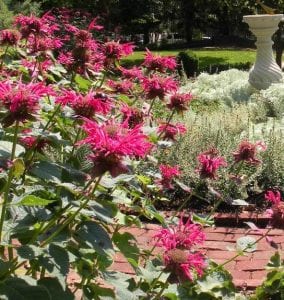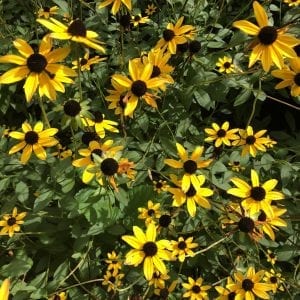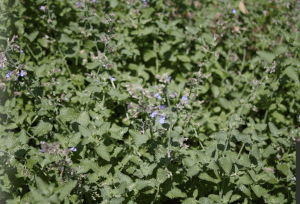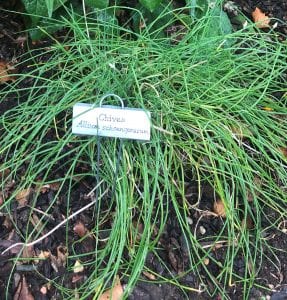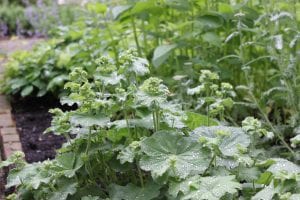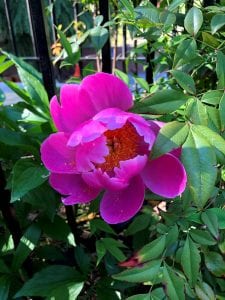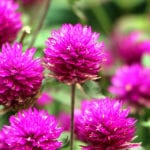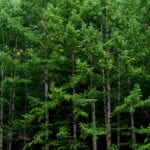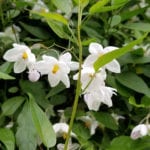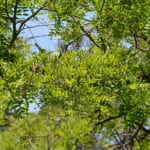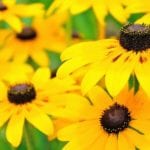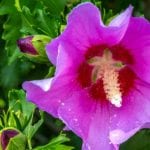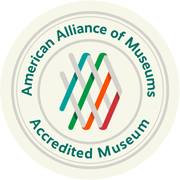The Grounds at Dumbarton
As much as the house itself, the grounds at Dumbarton House tell the story of early life in the nation’s capital and in the burgeoning American Republic.
Open Dawn to Dusk Every Day
Dumbarton House grounds are occasionally closed for a public program or private rental events.
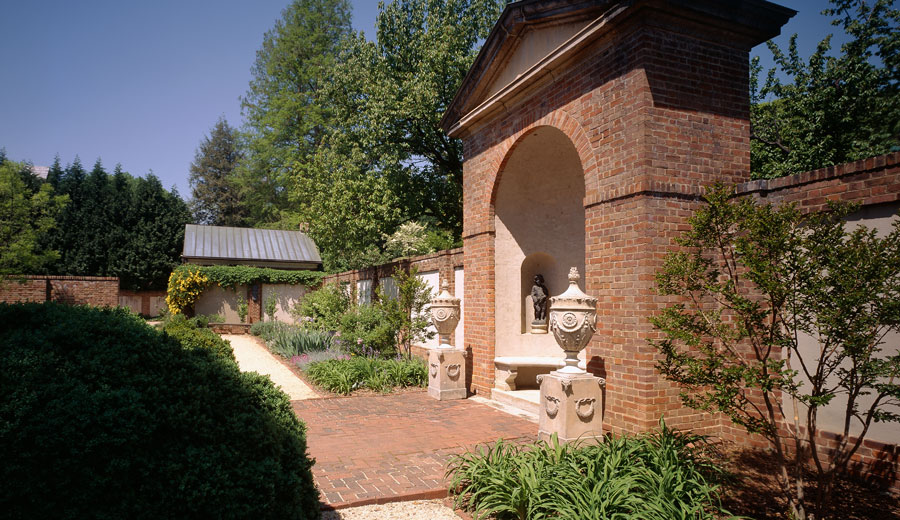
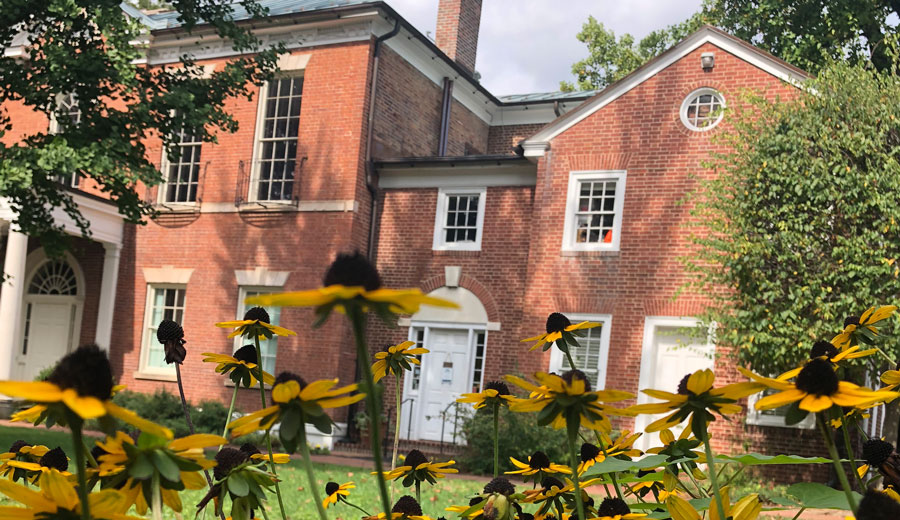
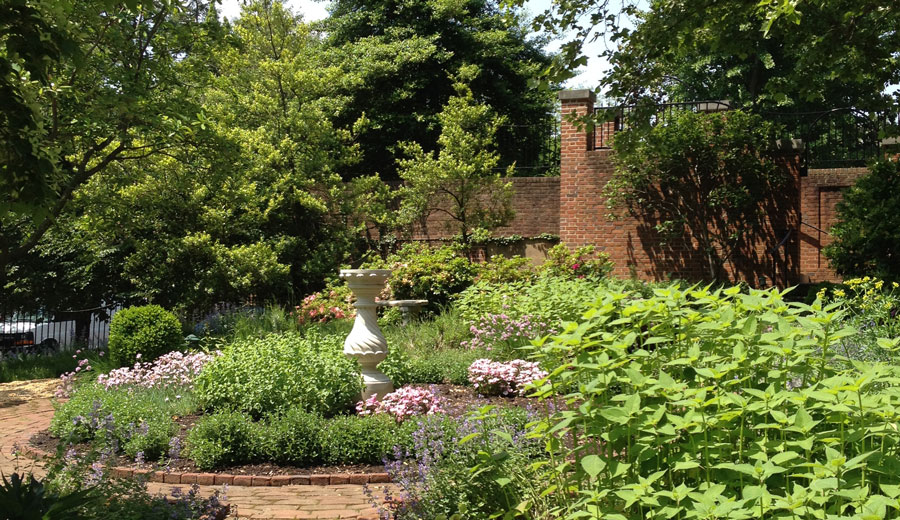
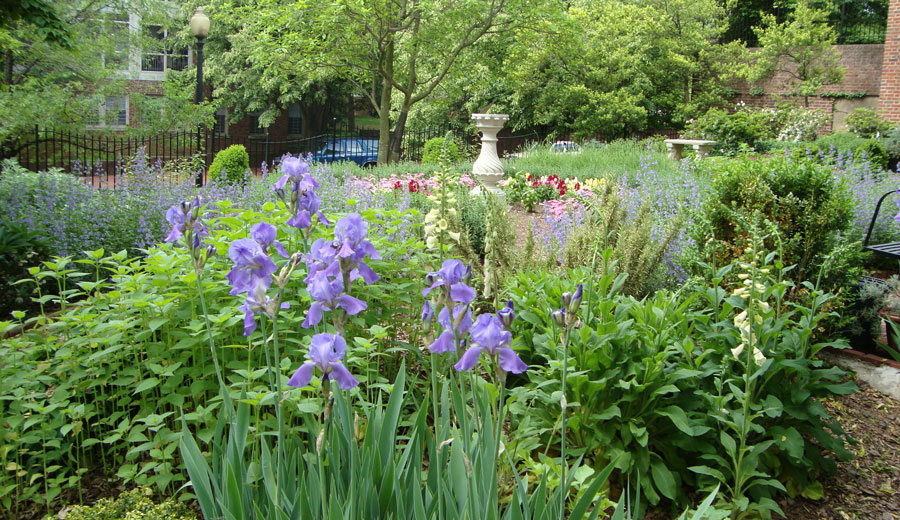
The Grounds Three Centuries Ago
When Dumbarton House was built in the early nineteenth century, the house was surrounded by eight acres of property. Joseph Nourse owned the land south of his home, running downhill from present-day Q Street to just south of P Street. Much of this land was likely a lawn, sparsely planted with groups of trees and shrubs, as was the fashion at the time. Joseph Nourse is also known to have purchased thorn plants from a local nursery to plant a hedge, a common practice to keep out curious wildlife and roaming farm animals.
Joseph Nourse’s land would also have been populated by a number of outbuildings. His writings indicate the existence of a number of these, including an ice house that he moved to his new property from his previous Georgetown residence.
A large barn with a stable and shelter for cattle was constructed into the slope of the hill to the north of the house. The barn also served as a carriage house and storage for hay and other material. Nourse also noted the efficiency of combining the dairy and smokehouse into a single structure, with an attached washhouse, stating that doing so “saves one roof and a foundation.”
Finally, the grounds also included quarters for the servants– enslaved, indentured, and free– who worked in the house and around the grounds.
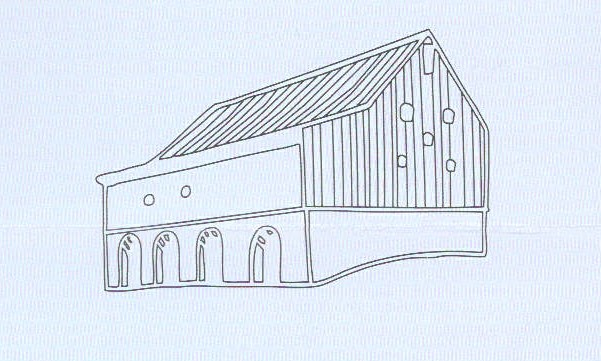
New Surroundings for Dumbarton
In 1915, as plans to bridge Rock Creek and join the Washington and Georgetown sections of Q Street took shape, it was determined that Dumbarton House (then called Belle Vue) would either have to be moved or demolished. Today, in its new location, Dumbarton House sits on 1.2 acres of gardens and terraces. The landscaping has evolved over the years, with some additions dating to when the house was moved and others made more recently. Below is a list of plants that appear on the property. Click their names to learn more about each one!
American Holly
Scientific Name: Ilex opaca
Plant Characteristics:
American Holly is native to North America and can be found from southern New England to Florida and west to Missouri and Texas. It can grow to 40 feet and leathery, dark green spiny leaves. Only the female tree has the bright red berries in the late fall and early winter. Hollies grow best in full sun to partial shade in moist, well-drained slightly acidic soil.
The American Holly in the west bed was planted in May 2014 in honor of Helen “Holly” Foss, who was a DC Dame and a docent at Dumbarton for over 20 years.
Plant Use:
Native Americans used the highly toxic berries to make a drink for ritualistic ceremonies that caused vomiting and purging.
The bitter tasting berries are a good winter food source for birds, deer, and wild turkeys. Flocks of robins in late winter can easily strip a tree of its berries in minutes. In this area the American holly serves as a host plant for Henry’s elfin butterflies.
It is a popular ornamental tree and cuttings of the green leaves and bright red berries are used to “deck the halls” at Christmas time.
American Hornbeam
Scientific Name: Carpinus carolinana
Plant Characteristics: The American Hornbeam is a small deciduous hardwood tree that is also known as blue-beech, ironwood, and musclewood. It is native to eastern North America from Minnesota to Maine and south to Texas and Northern Florida. It also grows in southern Canada, Mexico, Guatemala, and Honduras. The small tree reaches a height and spread of 20-30 feet. It is a shade-loving understory tree that prefers moderate soil fertility and loves a deep moist soil. The name hornbeam has reference to the extreme hardness of the wood – horn for toughness and beam, an old wood for tree.
Plant Uses:
The heavy, hard wood of the tree is used for tool handles, longbows, walking sticks, walking canes, and golf clubs. The common name, musclewood, comes from the resemblance of the trunk to flexed, well-defined muscles.
Deer browse the twigs and foliage, and the seeds are a valuable food source for many birds and squirrels. It is also a larval host for butterflies including the Eastern Tiger Swallowtails.
The eight hornbeams on either side of the upper terrace were planted in 2003. The landscape architect, Will Rieley recommended the hornbeams to create a natural arbor. He came up with the idea because according to his research, there were no wooden or metal arbors attached to houses in the Federal period.
Blackberry Lily
Scientific Name: Iris Domestica
Plant Characteristics:
Blackberry lily, also known as leopard lily, is a member of the Iris family and is native to Asia. It has fan shaped foliage like an iris, and lily-like spotted orange flowers. The plants bloom in July and August with a succession of flowers over a period of weeks. The unusual green seed heads that develop open to reveal a cluster of shiny black seeds that resemble blackberries. It is a short- lived perennial, but will self-seed and clumps can be divided to encourage new growth. Blackberry Lily likes lots of sun at least 6 hours a day and consistent moisture. The creeping rhizomes will rot in poorly drained soil.
Ten years ago the plants DNA was tested and it was determined that the plant was actually an iris not a lily. Previously the plant had its own genus with the botanical name Belamcanda chinensis.
Jefferson grew the Blackberry lily at Monticello and named it “Chinese Ixia.”
Butterfly Bushes
Scientific Name: Buddleja davidii
Plant Characteristics:
Butterfly bushes (Buddleja davidii) are native to China and are found growing on mountain slopes and rocky stream banks. The genus was named Buddleja to honor Reverend Adam Buddle an English botanist and vicar. The species name davidii honors Pere Armand David, a French missionary and naturalist who found the plant on the China Tibet border in the late 19th century. Butterfly bushes are vigorous growers with showy fragrant flowers that bloom from June to October. In the wild, flowers are in shades of purple, but new cultivars include pink, red, yellow and white. The shrub is an attractive nectar source for butterflies, bees and hummingbirds.
Butterfly bushes are easy to grow, drought tolerant, thrive in polluted urban environments and have no serious insect or disease problems, but are considered invasive in many states including Virginia. They are listed as an obnoxious weed in Oregon and Washington. Because the seeds spread so easily and the plants lack any natural predators, they can quickly take over the landscape.
Plant Replacement:
Native plants to the United States that provide nutritional needs for our local birds and insects and are host plants to many butterfly caterpillars are unable to thrive in areas where the butterfly bush has become established. If you have a favorite butterfly bush in your garden, it is recommended that the spent flower clusters be deadheaded to prevent the dust-like seeds from spreading. Since the butterfly bush attracts so many butterflies, you might consider some additional plantings in the garden that would serve as host plants for butterfly caterpillars. These include Common Milkweed, Swamp Milkweed and Butterfly Weed.
Chaste Tree
Scientific Name: Vitex agnus castus
Plant Characteristics:
The Chaste Tree is a native of China and India but has become naturalized throughout the South. Peter Henderson, an early American nurseryman, stated that the Vitex has been cultivated here since 1670. It is a deciduous multi-trunked tree that grows to 10-12 feet with a spread of 8-10 feet. The foliage has a pungent sage-like odor. It is particularly attractive in bloom when the pale violet spikes appear in July. The flowers are quite attractive to bees and butterflies. It prefers full sun and will row in a variety of soils as long as they are well-drained.
Plant Uses:
The Greeks used an extract of the plant to “calm the male inner fire.” In Medieval times there was a belief that utilizing potions made from the berries helped monks maintain their vows of chastity.
Clematis
Scientific Name: Clematis occidentalis
Plant Characteristics:
There are some 200 species of Clematis that occur throughout North America, Europe, and Asia. The large flat-flowered clematis species from China and Japan arrived in Europe in the late 1700s. The name is from the Greek clema, which means tendril. It climbs by twining its woody fragile stems around a form or structure. Flowers appear in late spring through early summer. Clematis prefers fertile, humus-rich, well-drained soil in sun or part shade. They are deer resistant.
Common Lilac
Scientific name for Common Lilac: Syringa vulgaris
Plant Characteristics:
The common lilac can grow to 20 feet with a spread of 8-10 feet. The fragrant flowers bloom in mid-Spring. Spent flowers should be removed, cutting back to a pair of leaves. It prefers full sun and rich, moist, well-drained alkaline soil. It does not do well in hot, humid conditions.
It is believed that the first lilacs came to this country in the 17th century. George Washington was known to have lilacs at Mt. Vernon and Thomas Jefferson wrote in his garden diary that he planted lilacs in 1767, 1771, and 1794.
Crape Myrtle
Scientific Name: Lagerstroemia indica
Plant Characteristics:
The Crape Myrtle is a small deciduous tree that is native to China and southeast Asia. It was first introduced to England and the United States in the eighteenth century and has been naturalized throughout the United States as far north as Massachusetts. It is commonly called the “Lilac of the South.” Crape Myrtles have a long blooming season of showy flowers in summer with a range of colors from many shades of pink, purple, lavender, and red to white. The flowers are borne in large panicles ranging from 6 to 8 inches in length and 2 to 3 inches in width. The fruits that follow are brown or black and when mature, split to release lots of disk-shaped seeds. The distinctive exfoliating bark provides architectural interest in winter. It can grow 30 feet with a spread of 15-20 feet. It needs full sun and prefers moist but well-drained, slightly acidic soil.
The common name refers to the crinkly flowers that resemble crepe paper. Crape Myrtle is not related to the true Myrtle.
Deodar Cedar
Scientific Name: Cedrus deodara ‘Kashmir’
Plant Characteristics:
Deodar Cedar is native to the Himalayas from Afghanistan to Nepal. The ‘Kashmir’ deodar has better cold hardiness than other species and can be found growing in the United States in zones 2 through 8. The tree has a pyramidal shape with soft silver-blue needles and drooping branches. It can grow to 60 feet with a spread of 20-30 feet. The fruit is a barrel-shaped upright 4 ½-inch green cone that ripens to a purple-brown. The cone disintegrates when it reaches maturity in 2-3 years. The tree does well in dry, sunny spots, and will tolerate clay soil.
Plant Uses:
The wood of the deodar is used in Asia for the construction of temples. In ancient Egypt, it was used to make sarcophagi for mummies.
Eastern Redbud
Scientific Name: Cercis Canadensis
Plant Characteristics:
The Eastern Redbud is native to North America and can be found from New York to Florida and west to Texas. It is a small deciduous tree that can grow up to 30 feet tall and 35 feet wide. In early spring numerous small bright pink to purple flowers appear in clusters nearly covering the bare twigs and branches.
The blossoms are a nectar source for early season butterflies and the tree is a larval host for the tiny Henry’s Elfin butterfly.
The large 3 to 5 inch wide and 5 inch long heart shaped leaves begin to emerge when the tree is in full bloom. The fruit is a flattened pea-like green pod 2 to 3 ½ inches long that becomes pink and ripens to brown and remains on the tree throughout the winter. Northern bobwhites and chickadees eat the seeds. It is an attractive specimen or understory tree. Redbuds like a fertile, moist but well-drained soil in sun or shade.
Jefferson listed Redbud in his book Notes on the State of Virginia, and planted it at Monticello and Poplar Forest, his retreat in Lynchburg. The 1932 Notes on a Restored Garden by Fiske Kimball has a listing of new plantings for Dumbarton House, which included 6 Redbuds. Unfortunately Redbuds are short lived and decline after 20 or 30 years due to disease
Plant Uses:
The flowers and buds are tasty to eat and can be served raw in salads or used to decorate cakes. Folk healers used the bark to treat diarrhea.
Forsythia
Scientific Name: Forsythia suspense var. sieboldii
Plant Characteristics:
Forsythia is a shrub native to eastern Asia and arrived in U.S. gardens in the mid to late 19th century. It was flowering at the Veitch Nurseries in England in 1857 and the Arnold Aboretum at Harvard received cuttings in 1876. The genus name honors William Forsyth (1734-1804) who was director of the Royal Gardens at Kensington and founding member of the Royal Horticultural Society.
Forsythia is a member of the olive family, is easy to grow and a good choice for difficult sites and poor soil. It has been nicknamed the Easter tree.
It is an arching, multi-stemmed, deciduous shrub and one of the first to bloom in spring with a profusion of bright yellow 4-petaled flowers along bare leafless branches. The medium green 2-4 inch long leaves begin to emerge after the flowers are open. They are toothed on the margins and arranged in opposing pairs along the stem. A location in full sun is best for flowering but it will tolerate light, dappled shade. Prune immediately after flowering because the buds for next spring’s flowers are produced on growth made the previous season.
Forsythia is easy to propagate from cuttings. Remove a new green branch near the base of the plant, trim to 24 inches making cut just below a leaf node. Poke the branch into 6-inches of soil, firm the soil around the branch and water well. It will quickly root and may bloom the following spring.
Foster's Holly
Scientific Name: Ilex x attenuata ‘Fosteri’
Plant Characteristics:
Foster’s Holly is a hybrid cross between Ilex cassine and Ilex opaca (American Holly) and was introduced into cultivation in the 1950s by E.E. Foster of Foster Nursery in Bessemer, Alabama. The female Foster’s Holly is one of the few female plants that will produce fruit without fertilization from a male pollinator. Therefore, it is not necessary to plant a male holly nearby for good berry production. Its red berries persist through much of the winter and are a food source for birds in late winter.
Foster’s Holly is a small evergreen pyramidal tree that reaches 15 to 20 feet in height with a spread of 8 to 12 feet and features shiny green 2 to 3-inch long spiky-edged leaves. Each leaf has 1 to 5 tiny, spiny, marginal teeth on each side. Small white flowers bloom in late spring, which are followed by a heavy production of brilliant red berries. It grows best in organically rich, medium moisture, well-drained, slightly acidic soil in full sun to part shade.
Dumbarton history: The Dumbarton Board meeting notes from 1933-1950 make several mentions of holly trees, mostly in regards to moving them around the grounds several times. They wouldn’t have been Foster’s Holly since that cultivar was not introduced until the 1950s, but some form of holly trees have been on the property since at least 1932 (need to find Fiske Kimball’s full planting list).
Hackberry
Scientific Name: Celtis occidentalis
Plant Characteristics:
Hackberry is a native North American tree that is widely found in the East, the Great Plains, and sporadically in the South. It commonly grows to 40-60 feet, but can reach a height of 130 feet. It is a member of the elm family, but is immune to Dutch Elm disease. The simple elm-like leaves are 2-5 inches long. The bark is gray in color and has randomly scattered warty outgrowths that develop into furrowed and scaly ridges with age. The small sweet orange-red to dark purple fruit is a source of food for many animals and birds. The tree serves as a larval host to many butterfly species. Hackberry grows naturally in moist bottomland soil but will grow in a variety of soil types from moist, fertile soils to hot, rocky, dry locations in fully sun.
Plant Uses:
Native Americans used hackberry extracts medicinally for sore throats, colds, and regulation of the menstrual cycle. The Dakota people used the dried fruit as a spice. The flexible wood is used for furniture, athletic goods, boxes, crates, and plywood.
Japanese Cedar, Sawleaf, and Snowbell
Scientific Name For Japanese Cedar: Cryptomeria japonica ‘Yoshino’
Plant Characteristics:
The Japanese Cedar is native to forested areas in Japan and China and is a species in the Redwood family. The foliage resembles the Giant Sequoias’. It is grown as an ornamental in parts of the United States and southern Canada. The ‘Yoshino’ has a symmetrical, pyramidal form and typically matures to 30-40 feet tall and 20-30 feet wide. The lime-green to blue-green ¾-inch evergreen needles are spirally arranged along drooping branchlets. Spherical 1-inch cones appear at the shoot ends. Best grown in moist, rich, fertile, well-drained soil in full sun. It can be injured by frost.
The name is derived from the Greek cryptos, hidden, and meros, part, because the parts of the flower are not easy to distinguish. It is the national tree of Japan where it is planted at temples and shrines. The tree works well as a windscreen and is a graceful, handsome specimen for parks.
Scientific Name For Japanese Sawleaf: Zelkova serrate ‘Village Green’
Plant Characteristics:
Japanese Sawleaf is native to Japan, Taiwan, and southern Korea. It is a medium to large deciduous tree that grows to 50-60 feet with a rounded umbrella-like habit when mature. The green flowers are small and insignificant and appear as the foliage emerges. The fruit is a small green rounded, nut-like, wingless drupe. The 2-5 inch long dark green leaves are elliptical with marginal teeth and ends in a sharp point. The light gray bark is smooth with small wart-like, corky swellings called lenticels that allow for the passage of oxygen and carbon dioxide. It grows in alkaline to acidic soils, is drought tolerant, and endures urban pollution.
‘Village Green’ is a more vigorous selection of this species with a straight trunk, and dark green leaves that turn a wine-red in the fall. It is often used as a replacement for the American Elm as it is similar in form and is resistant to Dutch Elm disease. Princeton Nurseries in Princeton, New Jersey introduced ‘Village Green’ in the 1960s.
Scientific Name For Japanese Snowbell: Styrax japanicus
Plant Characteristics:
Japanese Snowbell is native to China and Japan. It is a graceful, compact, deciduous flowering tree that grows to 20-30 feet tall with horizontal branching and a rounded crown. After the leaves have developed, pendulous clusters of white bell-shaped flowers with soft yellow centers and a light fragrance hang on short stems below the branches in May and June. Each flower has 5 petals that curve upwards and is ¾ of an inch wide. Flowers give rise to small greenish-brown, olive-shaped drupes that persist into the fall. The dark green simple 2-3 inch oval leaves with finely toothed margins have insignificant fall color but sometimes turn yellow and red. The gray bark with fissures on older branches reveals an orange inner bark that can be attractive in winter.
Styrax prefers a sunny location in moist, slightly acidic, well-drained soil. They need regular moisture and protection from the winter wind.
Korean Boxwood and Spice Viburnum
Scientific Name for Korean Boxwood: Buxus sinica var. insularis
Plant Characteristics:
he ‘Winter Green’ boxwood was introduced in 1960 and is commonly called Korean little leaf boxwood. It is cold hardy and is unlikely to bronze in winter, thus the name ‘Winter Green.’ This shrub does appreciate a good 2-inch layer of much to protect the roots from the elements and regulate the soil moisture and temperature. This dense, compact, slow growing evergreen can grow to 5 feet with a 3-5 foot spread. It is tolerant of pruning and shearing. Tiny but fragrant greenish yellow flowers appear in spring and are a favorite of bees. The ¾ inch small ovate leaves are a yellowish to medium green.
It grows best in average, well-drained, medium moisture soil in full sun to partial shade. It prefers protection from afternoon sun in hot climates and a sheltered location from cold, strong winter winds. It has some susceptibility to boxwood blight and leaf spot and has good resistance to leaf minor, psyllid, and mites. The root system is very shallow and can be easily damaged if smaller plants are planted too close or if the soil is cultivated around the plant.
Scientific Name for Korean Spice Viburnum: Viburnum Carlesii
Plant Characteristics:
Korean Spice Viburnum is native to Korea and Japan and has been cultivated for more than a century as a garden plant in the West. Carlesii is named for W. R. Carles who was with the British Vice-Council in Korea from 1883-1885 and collected plants throughout Korea. The slow-growing rounded deciduous shrub matures to 5 feet tall, but may grow to 8 feet. Pink buds open in early spring to fragrant blossoms that fade to white. They are arranged in pompom like clusters about 2 inches across. Flowers give way to non-showy, red berry like drupes that mature to blue-black in late summer. They attract birds and may persist through the winter. The dark green leaves turn a dull red in the fall. It is easily grown in average soil with medium moisture in full sun to part shade.
The intoxicating fragrance of the blossoms is sweet and rich with the scene of cloves, reminiscent of spice cake. It is recommended that it be planted in an area where the fragrance can be enjoyed.
Kousa Dogwood
Scientific Name: Cornus Kousa
Plant Characteristics:
The Kousa Dogwood is a beautiful Asian tree that is native to Japan, China and Korea. It is similar to our native dogwood but blooms later, mid or late May to early June, after the leaves appear. The four narrowly pointed petal-like white bracts that form the “flower” are actually modified leaves. The true flower is the insignificant yellowish-green cluster in the center. The fruits that resemble red raspberries form in late August. They are edible but are usually left for the birds. This small deciduous tree or multi-stemmed shrub typically grows to 15-30 feet tall and matures to a rounded form. It will grow in acidic, loamy, sandy, and well-drained clay soils. It prefers average moisture but is somewhat drought resistant.
This plant has better disease resistance and better cold hardiness than our native flowering dogwood, Cornus florida, and is a good alternative where the dogwood anthracnose is a problem.
Dumbarton House history: The dogwoods planted on the grounds after 1932 were most likely the native dogwood, as one note from the 1930s mentions “woodland” dogwoods. Unclear when these were removed, and it seems like a few more dogwoods were planted in the 1950s.
Lady Banks Rose
Scientific Name: Rosa Banksiae var. lutea
Plant Characteristics:
The rose grows wild in western and central China. It was introduced to the West in the early 1800s, and named after Lady Banks, the wife of the botanist Sir Joseph Banks, who directed London’s Kew Gardens. The climbing, sprawling shrubby vine grows vigorously to a height of 10 to 20 feet. It needs space for its massive growth and must be trained to a support. Unlike most roses it is nearly thornless. The cultivar “Lutea” has double yellow 1-inch flowers and is the most commonly cultivated variety in North America. It is probably the original “Yellow Rose of Texas”. Blooms appear in May and last about a month. Cold weather may delay flowering. It blooms on second and third year wood so prune only dead wood or as necessary to keep the plant in bounds. The rose is long-lived and has few problems with diseases or insects. Best grown in full sun, in moderately fertile, humus-rich, moist well-drained soil.
Dumbarton House history: Louise Talley of North Carolina donated the four Lady Banks roses in the North Garden in memory of her mother, Louise Trotter Wooten. They were planted in 2002.
Loblolly Pine
Scientific Name: Pinus taeda
Plant Characteristics:
Loblolly Pine is native to the east coast of North America from New Jersey to Florida and west to Texas. The name loblolly was given to three because of where it grew – in muddy, murky areas. It is actually an Old English word that means porridge. It is a tall, straight tree that has a fairly rapid growth rate and will reach a height of 60-90 feet with a spread of 25-35 feet at maturity. The pale green needles are grouped in bundles of three, with each one 6-7 inches long. The brown, prickly cones are 3-5 inches long. The bark on mature trees is reddish-brown, divided by shallow fissures into broad, flat-topped plates covered with thin scales. The tree prefers full sun and is usually found growing in moist, sandy soils.
Plant Uses:
Loblolly Pine is an important timber tree used to make brown paper and plywood. Early pioneers used the resin as an ointment, a rope preservation, as a sealing for roofing, and as a caulking for boats. Pine stands provide habitats for wildlife. The large trees are a common nesting site for osprey and bald eagles.
Loebner, Southern, Star, and Sweet Bay Magnolia
Scientific Name for Loebner Magnolia: Magnolia x loebneri ‘Merrill’
Plant Characteristics:
The Loebner Magnolia is a deciduous hybrid of M. Kobus and M. stellate. Max Loebner, a German horticulturist, made the first cross of this hybrid in the early 1900s. It typically grows to 30 feet tall with a rounded crown. It is more often grown in a multi-trunked form than as a single trunk tree. It is known for its winter hardiness and abundant star-like white flowers that appear before the foliage in early to mid-spring. Fragrant star-like white flowers with 10-15 petals appear in early spring before the leaves. Cone-like fruits ripen to red in late summer and release red-coated seeds at maturity. The 4-6 inch long dark green leaves turn a coppery bronze in the fall. The fruits are sometimes absent on this hybrid. Best grown in moist, organically rich well-drained soil in full sun to part shade.
‘Merrill’ is noted for its floriferous bloom of white flowers blushed with pink and its winter hardiness. It was developed at the Arnold Arboretum in Boston from seed sown in 1939. It was named to honor Elmer Drew Merrill, a botanist and third director of the Arboretum.
Scientific Name for Southern Magnolia: Magnolia grandiflora
Plant Characteristics:
The Southern Magnolia is a large evergreen that is native to the southeastern part of the United States. It was introduced to northern Europe in the early 1700s. It can grow to be 80 feet tall with a spread of 40 feet. It has large leathery leaves 5-10 inches long, 2-3 inches wide that are glossy dark green above with rusty brown hairs below. The creamy white blossoms appear in early summer and are highly fragrant. Native Americans avoided sleeping beneath a flowering tree, believing that the scent would overpower them. The fruit is a heavy gray brown pod that exposes bright red seeds in the fall. It prefers a well-drained, slightly acidic soil with high organic content in sun or part shade. Once they are established the roots should not be disturbed, not even to plant bulbs.
The magnolia flower is the state flower of Mississippi and Louisiana. In the English language of flowers, the magnolia is symbolic of love of nature.
Scientific Name for Star Magnolia: Magnolia stellate
Plant Characteristics:
Star Magnolia is a slow-growing shrub or small tree that is native to Japan and can be found growing by streams in moist, boggy areas. It was introduced to the United States in 1862 by George Robert Hall and has been widely cultivated in much of North America. In winter, the branches are covered in fat, fuzzy pussy willow-like casings. Beginning in March these buds swell to release showy white lightly fragrant 3-4 inch flowers. The blooms that resemble a starburst have 12-18 thin, delicate, strap-like petals and can last up to three weeks. Not all of the flowers open simultaneously, which adds to the length of its early spring show.
This tree eventually can reach a height of 20 feet with a spread of 10-15 feet. Its heavily branched, twiggy structure gives it winter interest with attractive, smooth, silvery-gray bark on the main trunk and shiny chestnut brown bark on the young twigs. It prefers acidic soil, but grows in many soil types while thriving in both cold and heat.
Scientific Name for Sweet Bay Magnolia: Magnolia virginiana
Plant Characteristics:
The Sweet Bay is native to the Atlantic and Gulf Coastal Plains from New York south to Florida. It is also known as Swamp Magnolia and White Bay. Thomas Jefferson planted Sweet Bays adjacent to his house at Monticello and made notes in his diary of the trees flowering on May 22, 1808. It is a hardy tree that is deciduous in northern latitudes and evergreen in the South. This small tree has a narrow, rounded crown and typically grows to 20-30 feet in height. Sweet Bay is named for its shiny bright green 3-5 inch long leaves that release a pleasant spicy odor when crushed. The cup-shaped 2-3 inch creamy white lemon-scented flowers appear between May and June. The flowers are followed by 2 inch cones of small red seeds that are relished by gray squirrels and a variety of birds. The tree is easily grown in acidic, medium to wet soils, in full sun to part shade.
Plant Uses:
Native Americans and European settlers used a concoction from the bark to treat fevers and rheumatism. The seeds were used to treat coughs and chest ailments.
London Planetree
Scientific Name: Platanus x acerifolia
Plant Characteristics:
The London Planetree is a hybrid believed to have resulted from a cross between the American Sycamore, P. accidentalis and the Oriental Planetree, P. orientalis. The original cross may have occurred as early as the 1600s, but the exact details of the tree’s origin have been lost over time. It was discovered that this hybrid could tolerate the smoke and grime of London and was widely planted throughout major European cities for nearly 400 years. The hybrid can be difficult to distinguish from its American parent, but there are a couple of features that can be used to differentiate between them. The fruits on the London Planetree usually appear in pairs, whereas the Sycamore has its fruits borne as one per stalk. The bark of the London Planetree is relatively smooth with an inner bark that is primarily olive-green, and the Sycamore bark strongly exfoliates in the summer to expose an inner mottled bark that is white, cream, green, and gray.
The London Planetree grows as a single trunk tree to 75-100 feet in height with a spread of 50-70 feet. It flowers in late spring but the flowers are inconspicuous. The fruit that develops is a spikey tan 1-inch bristly ball that is a food source for birds and squirrels in winter. The 4-9 inch wide leaves resemble maple leaves and turn an undistinguished yellow-brown in fall.
Maidenhair Tree or Ginkgo
Scientific Name: Ginkgo biloba
Plant Characteristics:
The Ginkgo is considered the oldest tree on earth, and is sometimes referred to as a living fossil. They are extinct in the wild and are only found growing in cultivation. One of the most distinguishing characteristics of the tree is the 2 ½ - 3 inch fan-shaped leaves that resemble the frond of a maidenhair fern. In autumn, the leaves turn a soft yellow and fall all at once. The tree can reach a height of 125 feet. They are native to the Orient and the name ginkgo in Chinese means “white nut,” which refers to the edible white kernel that is found inside the putrid fruit of the female tree. The trees need full sun and are tolerant of a wide range of environmental conditions.
The tree in the South Garden was planted in 1998 in honor of Mrs. Linda Mattingly, but with a word of caution from the landscape architect, Rudi Favretti. He wrote, “The only unfitting thing it is that you must insist on the male of the species (strange for honoring a female). That is because the female produces fruit that has an obnoxious odor.” The ginkgo has earned the name “stink bomb tree.”
Nandina
Scientific Name: Nandina domestica
Plant Characteristics:
Nandina domestica is commonly called heavenly bamboo or sacred bamboo. It is native to eastern Asia from the Himalayas to Japan and was brought to the West by William Kerr, who sent it to London from China in 1804. The plant belongs to the barberry family and gets its bamboo nickname because its upright cane-like stems and delicate compound leaves resemble bamboo. It can grow 4 to 6 feet high with a spread of 2 to 3 feet. The leaves are divided into many 1 to 2 inch pointed oval leaflets. They are a copper color in spring, turn a light green in summer and change to a reddish purple in the fall. The pinkish white flowers appear in late spring and are followed by clusters of red berries from fall to spring. The berries are poisonous to people, pets and birds as they contain a compound that decomposes to hydrogen cyanide. Excessive consumption of the berries during the winter will kill birds such as cedar waxwings, robins, and northern mockingbirds.
It is considered an invasive plant in the Southeastern United States and was added to the Maryland invasive plant list in May 2017.
In Shanghai berried sprays are sold at the New Year for the decoration of house altars and temples. Alice M. Coates, an acclaimed authority on the histories of flowers and plants, writes that in the Far East it is believed that nandina’s heavenly properties give it the power to dispel bad dreams. In Japan nandina is planted near doorways so that when you wake from a nightmare, you can step outside and tell the shrub your dream so no harm will follow.
Plumbago
Scientific Name: Ceratostigma plumbaginoides
Plant Characteristics:
Plumbago, also known as leadwort, is a semi-woody perennial from western China that was introduced to Europe and Britain in 1845. It is also native to eastern Africa. This spreading attractive ground cover grows 6-10 inches tall with slender stems that arise from branching rhizomes. In areas where the winter temperature goes below 15 degrees Fahrenheit the stems die back and new stems emerge in late spring. The oval 2-inch long glossy green leaves look fresh all summer regardless of the heat and humidity and in the fall turn a bronzy red. Clusters of gentian blue 5 petaled three quarter inch flowers appear above the foliage in late summer and bloom throughout the fall. Deep reddish calyces contrast with the blue flowers and add additional color. Plumbago is easily grown in average, well-drained soil in full sun to part shade. It is drought tolerant, deer resistant, and attracts butterflies.
The common name comes from the Latin word, plumbum, which means lead. The derivation of this common name is unknown but the plant was thought to be a cure for lead poisoning, according to the writings of Pliny the Elder in the first century AD.
White Coneflower
Scientific Name: Echinacea purpurea
Plant Characteristics:
White coneflower is a member of the aster family. Conrad Moench gave coneflowers the genus name Echinacea in the late 1700s. The Greek word echinos means hedgehog. This summer blooming herbaceous perennial is native to the central and southeastern United States.
There was a time when the flowers of Echinacea purpurea were only in shades of purple. Now with all the modern hybridization efforts you can find red, orange, yellow, green and white petal colors. A new feature in the North Garden is the cultivar Echinacea purpurea ‘PowWow White’. It is a more compact, heavily flowering new coneflower with 3-4 inch pure white flowers on sturdy, well-branched stems. It is deer resistant, drought tolerant, sun loving, winter hardy, easy to grow and will attract bees, birds and butterflies.
Plant Uses:
Native Americans used the plant to treat toothaches, sore throats, snakebites, and as a general cure-all. Today, the flowers are used to make an herbal tea that is believed to boost the immune system.
Quince
Scientific Name: Chaenomeles x superba ‘Cameo’
Plant Characteristics:
The “Cameo’ quince in the South Garden in the front of the house is a hybrid of the common flowering quince, Chaenomeles speciose and the Japanese flowering quince, C. japonica. The genus name comes from the Greek words chaino meaning to gape and melon meaning an apple.
Large semi-double apricot 2-inch flowers cover the spiny stems of ‘Cameo’ in early spring and attract pollinators to their rich source of nectar. The hard green fruits that follow ripen to a golden yellow by autumn. The fruit is very tart, especially if picked too early. They are edible but too bitter to be eaten directly from the shrub.
“Cameo” is easily grown in average, medium moisture, well-drained soil in full sun to part shade, but flowers best in full sun. It adapts well to a wide range of soil conditions and will tolerate dryish soils. Plants bloom on old wood so avoid heavy pruning. Prune to shape if needed in the spring after flowering. Root suckers should be removed to control the spread of the plant. This species has a neat rounded habit and typically grows to 3-4 feet tall and 4-5 feet wide.
Plant Uses:
High levels of pectin make the quince good for jellies and preserves. High organic acids give it the tart flavor and very high vitamin C content gives it nutritional value. Fill a bowl with the fruit to enjoy the fragrance in the house. In earlier times, quinces were stored with linens.
Red Spider Lily
Scientific Name: Lycoris radiata
Plant Characteristics:
Red Spider Lily is a member of the amaryllis family, and is native to China and Japan. It was introduced into the United States in the 1850s and has become widely naturalized in the southeastern United States. In late summer to early fall tall leafless stalks seem to pop up out of nowhere. The 18 to 24 inch stalks are soon topped with a cluster of bright red flowers that have long curling filaments giving it a spider-like appearance. After the flowers have withered, narrow grayish green basal leaves appear and overwinter in the garden eventually disappearing in late spring. The bulbs prefer partial shade and well-drained soil.
Lycoris radiata has many common names such as resurrection flower, surprise lily, magic lily and naked lady, which gets its name because the bare stems and flowers appear before the leaves. In Florida it is known as hurricane lily since it blooms at the height of hurricane season.
Rose of Sharon
Scientific Name: Hibiscus syriacus ‘Red Heart’
Plant Characteristics:
Rose of Sharon is a hardy deciduous shrub that is native to Asia. It was introduced to Europe in the 16th century. By the 18th century the shrub was common in English gardens and the American colonies. Thomas Jefferson grew Rose of Sharon from seed and planted them at all three of his houses. Rose of Sharon is easily grown in full sun to part shade in average, medium moisture well-drained soil. It can reach a height of 7-13 feet, and flowers prolifically over a long summer blooming period, attracting butterflies and hummingbirds. The ‘Red Heart’ variety features white trumpet shaped flowers with a ruby red center.
It is the national flower of South Korea.
Plant Uses:
Fine Gardening suggests harvesting some of the flowers to use as serving bowls for cottage cheese or dips. The flowers should be collected as soon as they are fully open and the pistols and stamens removed. Or, you can stuff the flowers with herbed goat cheese, press the petals closed, dip in beaten egg and breadcrumbs, and bake them. Petals can also be used raw in salads.
The Chinese used the flowers and leaves for food. The Koreans brewed the leaves for tea and ate the flowers.
Scholar Tree, Pagoda Tree
Scientific Name: Sophora japonica
Plant Characteristics:
This tree is native to China and Korea, but not Japan. The common name, Pagoda Tree, recognizes the early use of the tree in Japan around Buddhist temples. In China it is the symbol of the 8th moon, when the official examinations for political positions took place and was cultivated by aspiring scholars. It is a deciduous tree that can grow to 70 feet with a spread of 50 feet. Small fragrant pea-like creamy white flowers bloom in summer. Flowers give way to slender, 1-6 seeded, knobby, bean-like pods. It is best grown in rich, medium moisture, well-drained sandy loams in full sun to part shade. It is a good street tree as it is tolerant of common city pollutants and conditions. It is also a good shade tree for parks and suburban gardens.
Plant Uses:
Sophora japonica is one of fifty fundamental herbs in traditional Chinese medicine. It is used to promote optimal vein health.
Serviceberry, Shadbush
Scientific Name: Amelanchier Canadensis or Arborea
Plant Characteristics:
Serviceberry is a deciduous small tree that is native to North America. It has slightly fragrant white flowers in spring that produce small round purple to red berries that are sweet and attract wildlife. The tree can grow to 40 feet with a spread of 15-20 feet. It is easily grown in average soil with medium moisture in full sun to part shade. The colorful fall foliage is a blend of orange, gold, red, and green. The common name Shadbush was given to the tree by early settlers because the tree’s blooming coincided with the spring migration of shad. It was listed as one of the new trees for the restored Dumbarton garden in 1932.
Plant Uses:
The edible fruit is enjoyed by birds and small mammals. It can be used in jams, jellies, and pies, and can be dried like raisins. The Cherokees used serviceberry tea to aid digestion, and children who had worms were given baths in the tea. The wood is hard and strong and is used for furniture. Native Americans used the trees’ straight wood to make arrow shafts.
Spanish Bluebell
Scientific Name: Hyacinthoides hispanica
Plant Characteristics:
Spanish Bluebell, also known as wood hyacinth, is a bulb forming perennial plant that is native to Spain, Portugal and parts of Africa. It is in the asparagus family as is lily-of-the-valley. This late blooming spring bulb prefers cool, shady, damp, well-drained woodlands but is hardy and adapts well to various conditions. It seems to thrive on neglect and naturalizes easily by both bulb offsets and self-seeding. Each bulb produces a clump of strap shaped leaves and an upright, 12-18 inch rigid stem with bell-shaped, pale to mid blue flowers. It typically blooms April to early May. The flowers can be cut and brought indoors but the leaves should be left to die back as they take in nutrients to feed the bulb.
Sweet Autumn Clematis
Scientific Name: Clematis terniflora
Plant Characteristics:
Sweet Autumn Clematis is native to Japan and is a member of the buttercup family. It was introduced to the U. S. in 1877 as seeds sent to the Arnold Arboretum in Boston. The perennial is a tenacious, deciduous, twining vine with an extremely rampant growth habit that can reach to 30 feet. Blooming in late August through September it will often go unnoticed until it blooms. The individual 1-inch star shaped flowers are small, fragrant, and appear to nearly cover the plant in pure white. Bees and flies are drawn to its sweet vanilla-like fragrance. After the blossoms fade, the vine becomes a silvery mass of attractive fluffy plume-like seed heads. The seeds are easily dispersed by the wind and can travel far and wide with great enthusiasm to make more Sweet Autumn Clematis. In many places it is considered an invasive species. It is recommended that the vine be cut back to 3 feet after the flowers fade to discourage self-seeding. The seed heads are quite ornamental and make an attractive addition to a floral arrangement.
Sweet Autumn Clematis blooms best in full sun but will tolerate partial shade. The wine thrives in moist, well-drained soil and likes its roots kept cool with mulch or shade from other plants. It blooms on new growth, so can be cut back hard immediately after blooming or in the early spring to control its rampant growth. In the spring prune back to a pair of strong buds about a foot above the ground before new growth appears. The plant has few insect or disease problems, and is deer resistant and heat tolerant.
Tulip Poplar
Scientific Name: Liriodendron tulipifera
Plant Characteristics:
The Tulip Poplar is native to eastern North America from Ontario to Florida and west to Wisconsin. It is also known as yellow-poplar, whitewood, tulip tree, canary wood, and canoe wood. The Tulip Poplar can grow to over 100 feet and produces large showy flowers high in the tree. The flowers provide a nectar source for bees. Sprouts and buds are a food source for deer and birds, and squirrels eat the seeds. The wood is a valuable hardwood that is used for furniture, musical instruments and veneers. The tree has a massive root system that needs plenty of deep, rich, well-drained soil. The trees grow best in full sun and slightly acidic soil.
Plant Use:
According to The Folklore of Trees and Shrubs by Laura Martin, American Indians made a tea from the bark to treat upset stomach, rheumatism, and fever. Early American settlers made a tea that was a remedy for coughs. A solution made from the bark applied externally treated fractured limbs, cuts, and insect and snake bites. Leaves, crushed and made into a poultice, alleviated headaches. An ointment made from the buds soothed burns and skin disorders.
Dumbarton House history: According to a 1931 sales receipt from Towson Nurseries in Maryland, a 16-foot-tall Tulip Poplar was purchased for Dumbarton. It may be the tree that is flourishing in back of the house on the east side.
Virginia Fringetree
Scientific Name: Chionanthus virginicus
Plant Characteristics:
The Fringtree is native to the eastern United States from New Jersey south to Florida, and west to Oklahoma and Texas. In the Appalachians it is known as Grancy Gray Beard or Old Man’s Beard. It is a deciduous tree or small shrub growing to 20 feet with a spread of 10 to 15 feet. Chionanthus is Greek for snow and flower. The pure white, slightly fragrant flowers appear in spring just as the dogwood flowers fade. The blossoms’ nectar is a favorite of butterflies in spring and the blue fruit a favorite of birds in the fall. Fringetrees prefer a sunny location sheltered from wind and are best with some afternoon shade. They prefer moist, acidic soil.
In 1786, Thomas Jefferson, then living in France wrote to Philadelphia botanist John Bartram for seeds of this showy spring flowering tree to share with his Parisian friends.
Plant Uses:
The dried roots and bark were used by Native Americans to treat skin inflammations, and crushed bark was used in treatment of sores and wounds. In the 19th century physicians used a bark tincture to relieve congestion of glandular organs and the venous system. It was once considered a diuretic, a laxative, and a useful tonic to treat conditions such as hypertrophy of the liver.
Dumbarton House history: This may have been planted in 1932 by Fiske Kimball. It seems like there were two at one point in front of the arch, but since they began to block the urns the DH Board decided to move them. Maybe only one survived, or maybe it was replanted later.
Waxleaf or Japanese Privet
Scientific Name: Ligustrum japonicum
Plant Characteristics:
Wax Leaf Privet is an evergreen shrub that is native to Japan and Korea. It is a dense, fast-growing shrub that typically grows to 6-10 feet with a spread of 5-6 feet. The waxy deep green oval leaves with pale undersides are 2-4 inches long. Showy clusters of off-white flowers appear in May to early June and have a strong odor that some may find offensive, but they do attract butterflies. The flowers give way to small oval green drupes that turn black in September. Birds do not seem to be interested in the slightly toxic berries.
The privet is tolerant of most growing conditions, but prefers well-drained soil in full sun to partial shade. The foliage may scorch in full sun in hot summer locations. It has no serious disease or insect issues.
Witch Hazel
Scientific Name: Hamamelis x intermedia ‘Diane’
Plant Characteristics:
The Witch Hazel located between the driveway and the West Wing is most likely a hybrid cross between Japanese witch hazel (H. japonica) and Chinese witch hazel (H. mollis), and is probably the variety ‘Diane’ that blooms in mid- to late-winter. It was first introduced in 1969 and is named after the daughter of famed Belgian growers Robert and Jelena de Belder. ‘Diane’ has mildly fragrant red- to copper-red flowers with narrow, spidery, ribbon-like, crinkly petals. The 6-inch-long oval-shaped leaves turn to shades of yellow, orange, and red in the fall. ‘Diane’ is a medium to large vase-shaped deciduous shrub that grows to 8-12 feet tall and wide. It prefers organically rich, moist, acidic soil and blooms best in full sun but will tolerate part shade.
Plant Uses:
The twigs, leaves, and bark of the native witch hazel, Hamamelis virginiana, which produces yellow flowers in late fall, are used to make witch-hazel extract. The astringent is used to treat inflammation, insect bites, poison ivy, and others kin and eye irritations.
Winterberry
Scientific Name: Ilex serrata x verticillata ‘Sparkleberry’
Plant Characteristics:
‘Sparkleberry is a deciduous hybrid female winterberry that is a cross between the native, Ilex verticillata and a species indigenous to Japan, Ilex serrata. It was produced in 1961 by William Kosar at the National Arboretum in a breeding program, to develop hollies with highly ornamental qualities and improved adaptability to landscapes. ‘Sparkleberry’ inherited its ability to produce many plump red berries from its imported parent and to grow in damp wet soils from its native parent. This multi-stemmed hybrid that grows 10 feet tall and wide has simple 3-inch long dark green leaves that turn a golden yellow in late fall. They shed exposing masses of densely packed red berries along bare stems that attract many species of birds including cedar waxwings, robins, catbirds and thrushes. Overwintering birds generally do not eat the bitter, astringent fruit until other food supplies are gone. So the shrub with its dark gray bark and bright red berries is an attractive accent through most of the winter.
Winterberry hollies are dioecious. In other words the shrubs are either male or female. Both produce flowers but only fertilized flowers on female winterberries produce fruit. ‘Sparkleberry’ is a female cultivar and requires a pollinator for good fruiting. A male selection of the same cross, Ilex ‘Apollo’ was selected as a pollinator for ‘Sparkleberry’ since it provides sufficient pollen at the correct time. A male Ilex serrata or Ilex verticillata will also work.
Wood Betony
Scientific Name: Stachys officinalis
Plant Characteristics:
Wood Betony (Stachys officinalis), also known as hedgenettle, purple betony and bishopswort, is native to Europe, western Siberia and northern Africa. It is a summer blooming perennial with a long history of use as a medicinal herb.
Betony is a clump forming perennial with aromatic basal foliage and reddish purple flowers that form whorls along 1 to 2 foot tall spikes. It is easy to grow in average, well-drained, moderately moist soil in full sun to partial shade. It is a good choice for shady areas where few flowering plants will thrive. The plants will self-seed and should be divided every 3 to 5 years to prevent overcrowding. It is drought tolerant, deer and rabbit resistant and attracts bees and other pollinators.
Plant Uses:
The ancient Greeks extolled its healing power for any and all ailments. In addition to having medicinal virtues it was believed to have power to ward off evil spirits and was grown in churchyards and monastery gardens. Today it is used in teas to make a soothing drink to treat headaches.
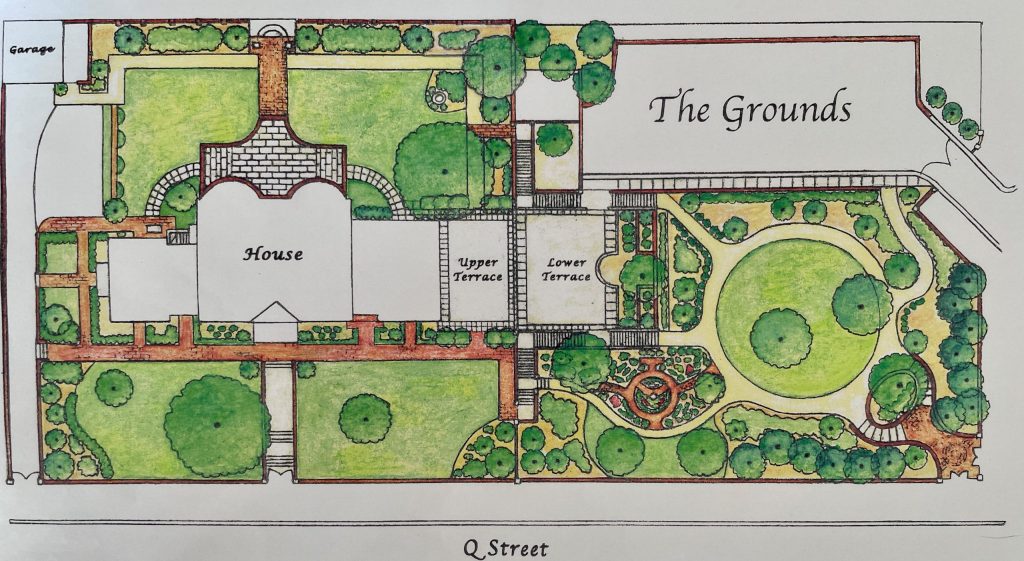
The East Park
The East Park is a landscaped area just to the east of the house itself which is open to the public. As part of the NSCDA Centennial efforts in the early 1990s, it was decided that the vacant lot adjacent to Dumbarton House, donated to the NSCDA in the 1960s by the Belin family, should be turned into a garden. The Georgetown Garden Club graciously funded the plant material, the planting itself, as well as the landscape design of the park.
The park was designed by noted landscape architect M. Meade Palmer. Palmer graduated from Cornell University with a degree in landscape architecture and achieved renown in the Washington, D.C. area for his minimalist designs, which often incorporated plant species native to the region. Palmer’s other notable landscape designs in the area include Bull Run Regional Park in Manassas and the Lyndon B. Johnson Memorial Grove in Lady Bird Johnson Park on the Potomac River.
Dumbarton House is grateful for the Georgetown Garden Club’s generous donation which made the beautiful East Park possible.
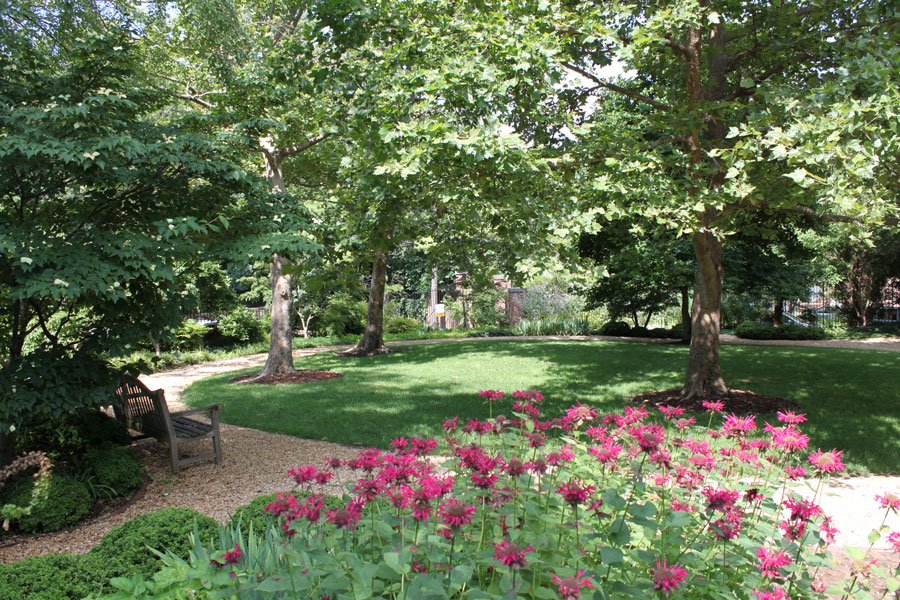
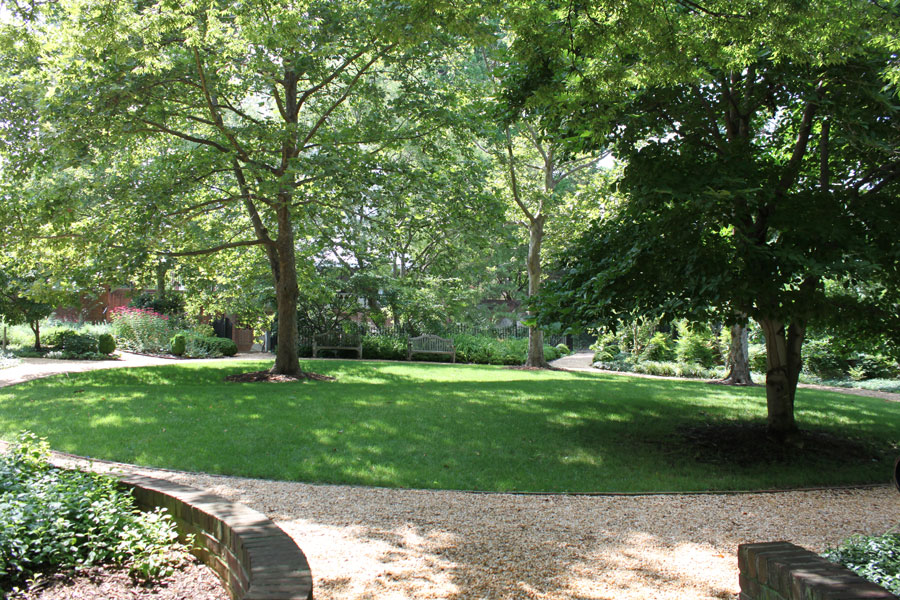
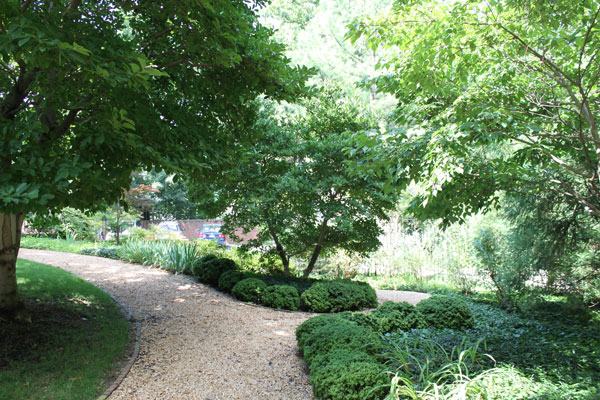
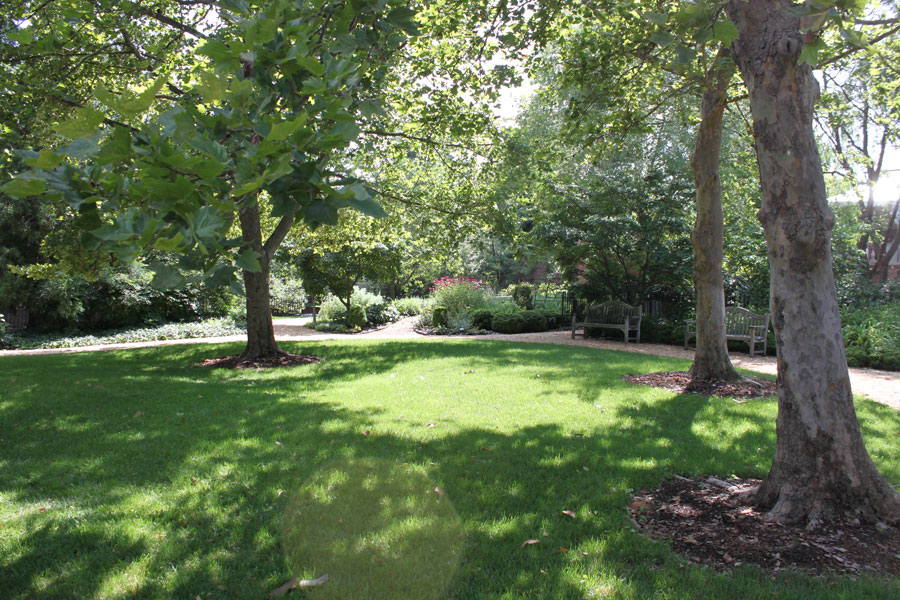
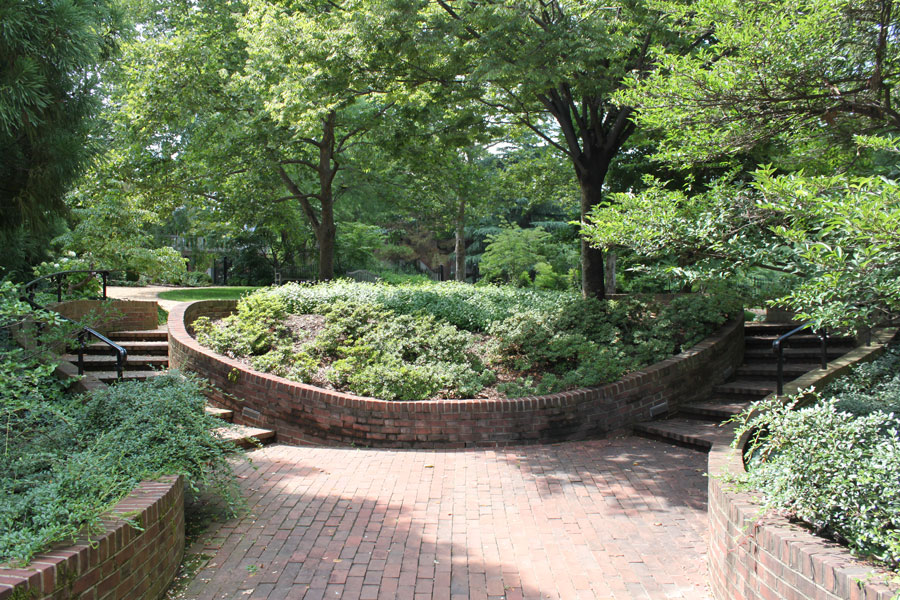
The Herb Garden
As part of Dumbarton House’s efforts to interpret the historic house and grounds, a landscaping plan was adopted in late 2009 which, among other things, called for the creation of a historically-appropriate herb garden. Dumbarton House Advisory Committee member Guy Williams of DCA Landscape Architects, Inc., designed the garden and researched which plants would be appropriate for the recreation of a 19th-century herb garden. DCA Landscape Architects is an award-winning Georgetown-based firm which plans and executes projects ranging from small gardens to large-scale master planning and estate planning.
Plants would fall under one or more of several general categories of use, ranging from culinary and medicinal to aromatic and economic. The result is a landscaped herb garden with over 40 different plants, herbs, and flowers which in the 18th and 19th centuries were used in everything from herbal teas to soaps and perfumes.
Below is a list of all the plants that can be found in our herb garden. Click a plant to see more information about its uses and characteristics. Much of the information about the plants in our gardens comes from Herbs & Herb Lore of Colonial America, published by the Colonial Dames of America.
Basil
Scientific Name: Ocimum basilicum
Plant Characteristics: Basil is considered a tropical annual herb. It is part of the mint family, and thus shares a mind identification characteristic of having a square stem. The leaves have a sweet and spicy smell and taste.
Plant Uses:
Culinary: Even today, basil is used as a fresh or dried herb for cooking.
Medicinal: It was thought that “a root of basil held in the hand with a swallow feather [would] relieve the pains of a woman in childbirth.”
Beebalm
Scientific Name: Monarda didyma
Plant Characteristics: This plant is in the mint family, and thus has a square stem. It has opposite, pointed leaves and, in the summer, bright scarlet flowers that attract hummingbirds.
Plant Uses:
Aromatic: Beebalm was made into an oil that was used in soaps and perfumes.
Medicinal: Early Americans used Beebalm leaves to make a tea to treat colic, fever, and colds.
Black Eyed Susan
Scientific Name: Rudbeckia fulgida
Plant Characteristics: This plant is considered a long-blooming perennial, with yellow-orange daisy-like flowers that bloom from June to October.
Plant Uses:
Medicinal: Native Americans used the roots and sometimes the leaves of this plant to make a tea to treat worms, colds, cold sores, and cuts. Juice squeezed from the roots was also used to treat earaches.
Borage
Scientific Name: Borago officinalis
Plant Characteristics: This annual herb is native to the Mediterranean region. Its flowers, usually blue but sometimes pink or white, bloom from June to October.
Plant Uses:
Culinary: Fresh Borage flowers were used as decorations in drinks.
Medicinal: From ancient through colonial times, the edible leaves were used to support feelings of health and courage. An “infusion” of Borage flowers were used to treat fevers, bronchitis, and diarrhea. Today, the plant is commercially cultivated for Borage seed oil, which has many health properties.
Catmint
Scientific Name: Nepeta cataria
Plant Characteristics: Catmint has grayish square stems with aromatic gray-green leaves. Its long blooming fragrant purple and white flowers bloom from May to September.
Plant Uses:
Medicinal: An aromatic tea was made using fresh or dried Catmint leaves strained and sweetened with honey. The tea helped alleviate anxiety, aid in sleep, promote perspiration to reduce fever, soothed sore throats, and calmed upset stomachs.
Fun Fact: Catmint is the “true catnip” loved by house cats.
Chamomile
Scientific Name: Anthemis nobilis
Plant Characteristics: Chamomile is a sweet-smelling perennial that grows between 10 and 12 inches high.
Plant Uses:
Medicinal: This plant was used as a sleep-inducing herb, and an external treatment to ease aches and pains. Chamomile was also used to help ease poor digestion.
Chives
Scientific Name: Allium schoenoprasum
Plant Characteristics: Chives form in clumps of pungent hollow stems with small balls of pink to mauve flowers that bloom in the summer.
Plant Uses:
Culinary: Chives have a mild flavor reminiscent of onions. They were used, and still are used today, in a wide variety of dishes ranging from soups and stews to meat and fish.
Dill
Scientific Name: Anethum graveolens
Plant Characteristics: This hardy, short lives annual has fragrant leaves that grow in early spring, with yellow flowers that bloom in the summer.
Plant Uses:
Culinary: Dill was used, and is still used as an herb for flavoring and pickling.
Medicinal: Dill is used as a stimulant. It was also used to ease digestion and to help stop hiccups and colic.
Fun Fact: During colonial times, Dill was called “meeting seed,” because ladies would eat Dill to keep from falling asleep during long church sermons and other meetings. They also fed Dill to their children for the same purpose.
Evening Primerose, Sundrops
Scientific Name: Oenothera fruticosa ‘Fireworks’
Plant Characteristics: Has deep bronze foliage and red stems with red buds that open to canary yellow flowers in June. The flowers only last a day or two but open in succession to give the plant the appearance of continuous bloom. It deer resistant.
Plant Size: 15-18 inches tall and 12-15 inches wide
Plant Uses: It has been known for hundreds of years as the “King’s Cure All” for it’s reputed ability to promote healing of skin diseases and flesh wounds.
Fun Fact: This plant blooms fully at night and is pollinated by nighttime insects such as the nocturnal Sphinx Moth.
Cultural Needs: Does best in full sun to light shade in well-drained, sandy soils. It has a vigorous sprawling clump habit and is drought tolerant. After the first flush of bloom, cut back to half to promote a new slush growth.
Fairy Wings
Scientific Name: Epimedium alpinum
Plant Characteristics: Fairy Wings, also known as Barrenwort, is a low growing deciduous ground cover with small red to yellow flowers that bloom in May.
Plant Uses:
Medicinal: Drinking an extract of Barrenwort root would make a person infertile.
Foxglove
Scientific Name: Digitalis purpurea
Plant Characteristics: This biennial plant produces large, dense spikes of tubular flowers in a range of colors in spring and early summer. The first year, Foxglove plants from a rosette at the base of the plant, and bloom the following year.
Plant Uses:
Medicinal: Some Colonial patients were given a pill made from Foxglove leaves for use as heart regulation medicine. Foxglove was also used as a diuretic. In large doses, drugs made from Foxglove were poisonous.
Germander
Scientific Name: Teucrium chmaedrys
Plant Characteristics: Germander is an evergreen ground cover with lavender flowers that bloom from July to August.
Plant Uses:
Medicinal: Germander was used to alleviate uterine obstructions and to reduce fevers, rheumatism, and gout.
Globe Amaranth
Scientific Name: Gomphrena globosa
Plant Characteristics: Globe Amaranth is an annual with large, brilliant magenta flowers.
Plant Uses:
Decorative: This long-blooming flower was picked throughout the season and hung to dry to be used in dried flower arrangements.
Fun Fact: Globe Amaranth was perhaps the most popular annual flower of the colonial era. The plant originated in India, and made its way to America in Pennsylvanian gardens via England.
Hyssop
Scientific Name: Hyssopus officinalis
Plant Characteristics: Hyssop is a perennial plant with showy, fragrant blue-purple flowers that bloom in the summer.
Plant Uses:
Aromatic: Hyssop oil was used to make perfumes. Hyssop was also often strewn on floors because of its aromatic and antiseptic qualities.
Culinary: Hyssop leaves were dried and chopped as an herb.
Medicinal: Hyssop was used as an antiseptic. The flowers and green tops were alsue used to make a tea for use as a cough suppressant, expectorant, and to soothe sore throat. The leave could be ground into a paste to cover open wounds.
Indigo
Scientific Name: Baptista australis
Plant Characteristics: Indigo is a long-lived perennial with soft gray-green foliage and indigo blue flowers that bloom from May to June. After the flowers bloom, Indigo sprouts attractive dark seed pods.
Plant Uses:
Economic: Indigo leaves are used to make a blue dye for cloth.
Fun Fact: Indigo originated in India and Egypt, and was used by the Romans to make ink. European traders brought the plant to Europe in the 16th century for the purpose of making dyes. The earliest recorded use of Indigo in the American colonies was in 1649, as colonists hoped to develop a profitable industry to compete with Indian Indigo trade.
Crested Iris
Scientific Name: Iris cristata
Plant Characteristics: This fast-growing plant has short broad leaves and sky blue flowers that bloom in the spring.
Plant Uses: The Crested Iris was planted in the Dumbarton House herb garden because the plant is native to the Eastern United States. It was commonly found in American gardens throughout the colonial period and beyond.
Lady’s Mantle
Scientific Name: Alchemilla mollis
Plant Characteristics: This plant grows in mounds or clumps. Lady’s Mantle has pale green, hairy round leaves and small yellow-green flowers that attract bees.
Plant Uses:
Medicinal: Lady’s Mantle was used to reduce internal bleeding. The plant’s leaves were also used topically to firm sagging breasts.
Lily of the Valley
Scientific Name: Convallaria majalis
Plant Characteristics: This plant grows to be about 8 inches tall. Lily of the Valley spreads via underground stems called rhizomes. With these rhizomes, Lily of the Valley can form very large colonies.
Plant Uses:
Medicinal: Most parts of Lily of the Valley are poisonous; however, this didn’t stop colonists from making medicines witht the plant. The dry rhizome was used as a heart stimulant and for the treatment of epilepsy. A powder made from the roots was used to slow one’s pulse. Finally, water distilled with the flowers was used as an eyewash.
Oregano
Scientific Name: Origanum vulgare
Plant Characteristics: Oregano is a low-growing herb with gray green foliage, with a flower that blooms in the summer.
Plant Uses:
Culinary: Oregano was used, and still is used today as a cooking herb, fresh or dried.
Medicinal: Early Americans used Oregano to treat stomach aches, consumption, scurvy, jaundice, toothaches, swelling, and headaches.
Peony
Scientific Name: Paeonia lactiflora ‘Festiva Maxima’
Plant Characteristics: A long-living perennial. It has large white fragrant blooms with occasional specks of crimson at the base of the petals. Produces the showy flowers on sturdy stems in early June and the foliage remains attractive throughout the growing season.
Plant Size: 3 ft tall and 3 ft wide
Plant Uses: The Colonists planted peonies for the flowers. Their heirloom species was introduced to the U.S. in 1852.
Cultural Needs: Full sun and neutral to slightly sweet soil/ Prefers some afternoon shade in the South.
Mint Species
Scientific Name: Mentha piperita (top image), Mentha spicata (bottom image)
Plant Characteristics: Mint is a perennial with fragrant and tasty leaves.
Plant Uses:
Aromatic: Oils from Mint plants were used in perfumes.
Culinary: Mint leaves have been used to flavor drinks and food. Oil from the plant was also used to make gum and candy.
Medicinal: Mint oil was used in various medicines. The leaves were also used to make a tea that helped relieve upset stomachs. Mint was also used to make toothpaste.
Fun Fact: Mint species are native to the Mediterranean island of Corsica. By the Middle Ages, mint was used throughout Europe. The plant was brought to the American colonies very early on, and mint was growing wild in New England by around 1672.
Pinks
Scientific Name: Dianthus gratianopolitanus
Plant Characteristics: This plant is a low-growing perennial with soft, sweet-smelling pink flowers that bloom from May to June.
Plant Uses:
Aromatic: Pinks flowers were used in potpourri as a substitute for cloves.
Culinary: Pinks flowers were used to flavor wine, ale, syrups, sauces, and jams.
Rosemary
Scientific Name: Rosmarinus officinalis
Plant Characteristics: Rosemary is an evergreen perennial with fragrant leaves and showy flowers that bloom in the summer.
Plant Uses:
Culinary: Rosemary has a distinct flavor, and was used in meats, breads, cakes, puddings, and other foods.
Medicinal: Rosemary was thought to have numerous benefits relating to the hair and scalp. It was used to improve circulation in the scalp, and to treat dry flaky scalps and thinning hair. The herb was also used to help dry skin, acne, and eczema.
Symbolic: Rosemary was a symbol of remembrance and fidelity. Colonists tied sprigs of Rosemary into a bride’s bouquet. The herb was also given as an offering of remembrance at funerals.
Rue
Scientific Name: Ruta graveolens
Plant Characteristics: This plant is a rounded evergreen shrub with fragrant blue-green leaves.
Plant Uses:
Spiritual: Rue was sometimes known as the “Herb of Grace,” and was used to sprinkle holy water in churches. The plant was also used as a part of charms to ward off evil spirits and witches.
Medicinal: This plant was thought to improve vision. Rue was also used to treat ailments of old age, such as stiff joints.
Fun Fact: In early history, Rue was a symbol of repentance.
Sage
Scientific Name: Salvia sclarea
Plant Characteristics: Sage is a short-lived perennial with thick square stems covered in hairs. Sage has large upright flowers ranging in color from lilac to white to pink.
Plant Use:
Aromatic: Sage flowers have an attractive vanilla-balsam fragrance.
Medicinal: While there is little explicit reference to the medicinal uses of sage in the American colonies, the plant was widely used in Europe to treat a number of ailments. Sage was thought to enhance the immune system, ease digestion, and reduce skin inflammation.
Sweet Woodruff
Scientific Name: Galium odorata
Plant Characteristics: Sweet Woodruff is a perennial ground cover with small white star-shaped flowers.
Plant Uses:
Aromatic: Colonists mainly used Sweet Woodruff as a strewing herb, laying the plant on the floor to improve the smell of a room for special occasions, such as festivals, weddings, and funerals. Flower stalks were also hung up as air fresheners.
Fun Fact: Unlike many other plants, Sweet Woodruff’s strong scent increases, rather than decreases, as the plant wilts. The plant also retains its scent when dried, making it an excellent ingredient in potpourri. Sweet Woodruff was also used as a moth deterrent.
Thyme
Scientific Name: Thymus vulgaris
Plant Characteristics: Thyme is an evergreen ground cover with small oval leaves and fragrant flowers. The color of the flowers depends on the species.
Plant Uses:
Aromatic: Thyme was used as a strewing herb, strewn on floors to improve the scent of rooms. Oil from the plant was also used in soaps.
Culinary: Thyme is used as an herb in a variety of dishes ranging from fish and salads to soups and sauces.
Medicinal: Thyme leaves were made into a tea to help diminish nightmares. Thyme was also used to treat gout, joint pain, the palsy, epilepsy, coughs, earaches, and headaches.
Fun Fact: The English believed that Thyme was a favorite plant of fairies, claiming that those who wiped their eyes with the plant would gain the ability to see the magical creatures.
Wood Betony
Information TBA
Wormwood
Scientific Name: Artemisia absinthum
Plant Characteristics: Wormwood has upright stems with silvery leaves and small yellow flowers that bloom from July to October.
Plant Uses:
Aromatic: Colonists used the plant to deter moths from eating clothing. Wormwood seeds were known to repel fleas, and they were also sprinkled in books to repel book lice.
Culinary: Fruit from the plant was added to hops to make beer.
Medicinal: Wormwood was used externally to relieve sprains and bruises. Internally, Wormwood was used to cleanse the stomach, and to treat liver ailments, scurvy, grout, fevers, and intoxication.
Fun Fact: Wormwood is a primary ingredient in a powerful alcoholic drink called absinthe, which has been banned in many countries. Famous artist Vincent Van Gogh painted some of his most famous works under the influence of the powerful drink.
Yarrow
Scientific Name: Achillea millefolium
Plant Characteristics: Yarrow is a perennial with a variety of flower colors. Yarrow grows white, red, or pink flowers that bloom from May to June.
Plant Uses:
Medicinal: This plant was very important in medicine, as colonists used Yarrow to stop bleeding.
Fun Fact: The name Yarrow may have originated with Achilles, who used the plant on the battlefield to stem the bleeding from his men’s arrow wounds.


